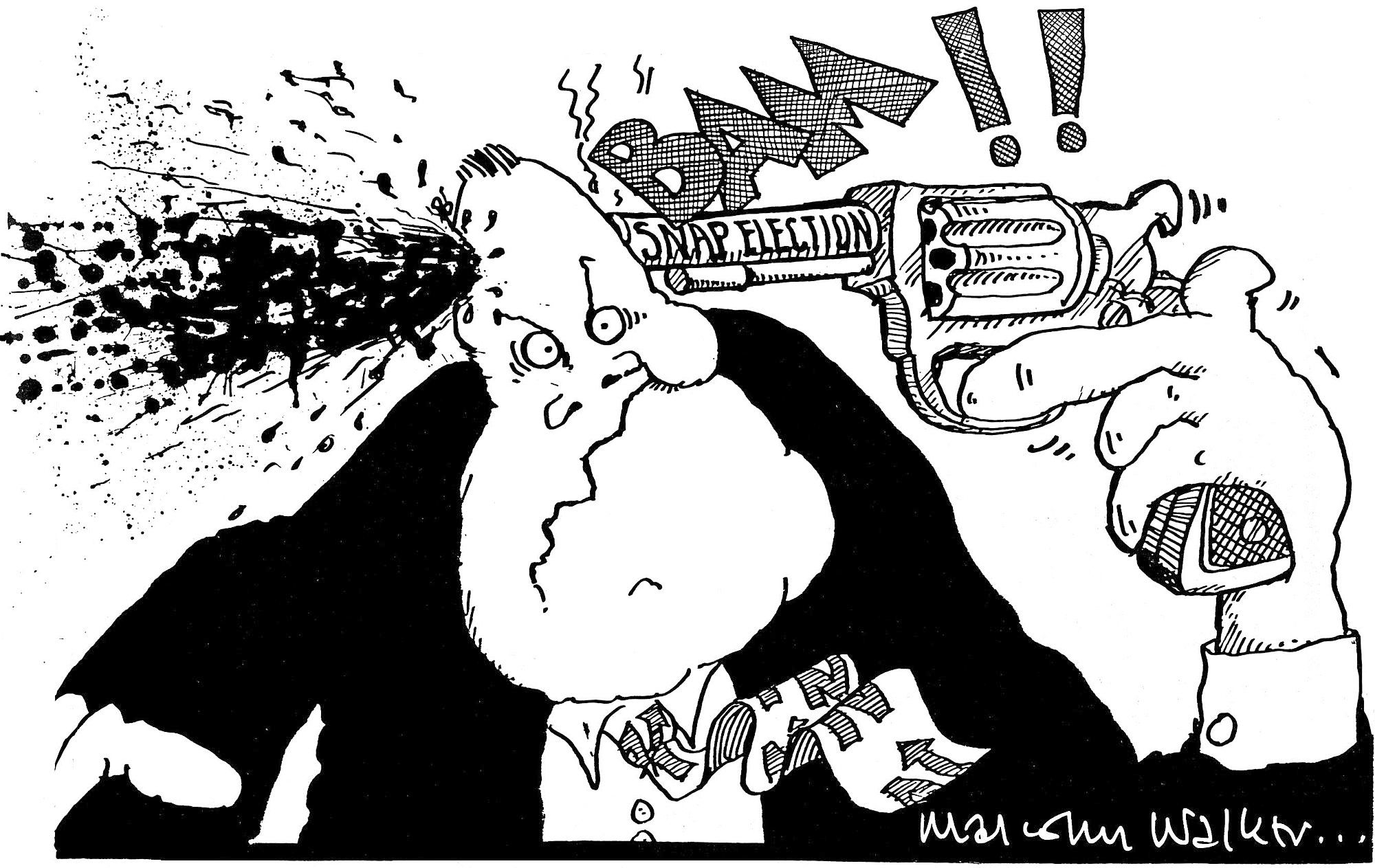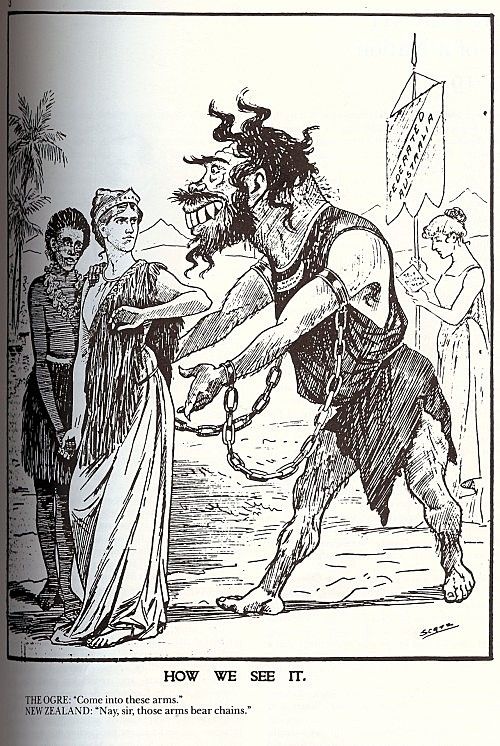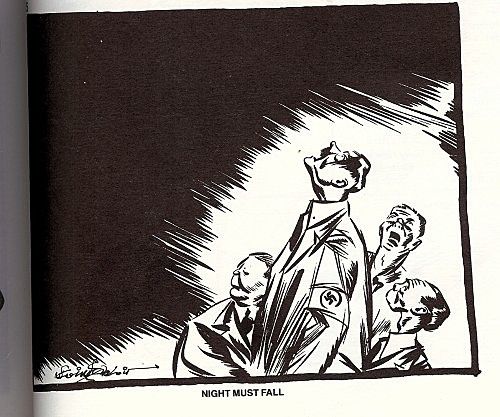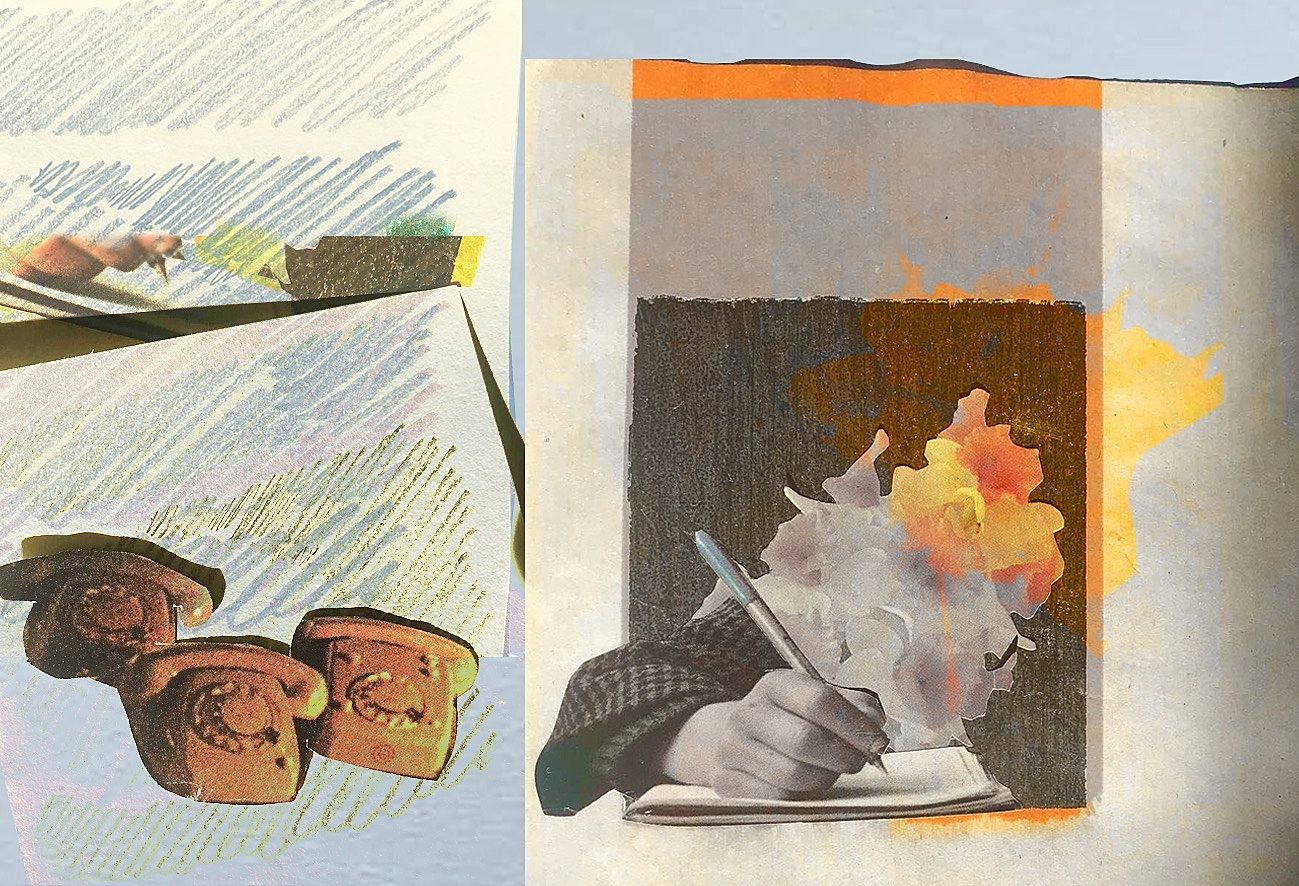Portrait of a Super Carder: Brief Chats with Political Cartoonists
Political cartoonists: even they think they're dying. Ahead of their panel at the Going West Books and Writers Festival this Sunday, we chat to three of the best editorial cartoonists in the country about what it means to do what they do.
They're our most rapidly aging population, the sub-species most in danger of technological and literal extinction. Forget birds. Forget snails. It's the New Zealand political cartoonist that's most in danger of disappearing - so much so that earlier this year we saw the launch of an inaugural award to try and replenish them. "Nearly all of today's established cartoonists have been delivering their brickbats and bouquets for decades," Listener readers were solemnly told, "So, before long, the country's newspapers and magazines will need new talent to fill some big shoes." A breeding programme of sorts, but will it make a difference as their newsprint habitat recedes? And with high-profile aesthetic attacks in the wild like Al Nisbet's ratshit attempts at satire in May this year, does the public even want to see them saved?
But hey, what do you expect from an band of social commentators this far into their dotage? Ian F Grant, founder of the New Zealand Cartoon Archive, initiated the Listener competition "because of my concern that most of the country's cartoonists were in or approaching the Super Card years. There is a tradition of cartoonists being on a paper for decades – Sir Gordon Minhinnick was at the NZ Herald for 50 years – so there are few opportunities for fresh blood, particularly as there are fewer dailies in NZ than 20 years ago." Interviewing Grant in the magazine, Karl du Fresne called it a 'succession plan'.
The winners were recognised at an award ceremony in May, but this is a niche where even a good artist doesn't get the luxury of pitching for the galas. You need to keep churning content, ideas, concepts out with a sort of dogged determination that doesn't offer you the highs (or perhaps, the lows) of more expansive projects. Being able to draw well for the medium is one thing - then you need to be able to say more with less and less, to try and avoid the sort of clunking literalism that The Onion riffs on with its fake editorial cartoons. You need to be able to draw something that looks like Peter Dunne, but you need to be able to do it quickly. You need to be 'irreverent', but you're often still writing for a stoic old paper of regional record, so don't do anything weird.
The old blood isn't going anywhere just yet, and before it does you'll be able to catch a rare sighting this Sunday at the Going West Books Festival. Ahead of the day, we chatted to the panelists about their careers and their thoughts on who'll fill those well-worn shoes:
The Panelists
Ian F Grant was a founder-director of National Business Review in 1970 and founder of the New Zealand Cartoon Archive. He is the author of four New Zealand cartoon histories and will be a sort of Attenborough figure at Sunday's talk.
Malcolm Evans is editorial cartoonist for the Christchurch Press, Timaru Herald, Manawatu Standard and Northland Age and draws popular farming character Edna for NZ Rural News. He served two stints as a NZ Herald columnist for a total of 14 years and has been twice been named Cartoonist of the Year. The most 'controversial' figure in the lineup, his Herald employment ended shortly after he refused to self-censor editorial cartoons critical of Israel and Zionist expansion policy. The straw that broke the camel's back was allegedly this one.
Malcolm Walker draws for NZ Doctor, Architecture NZ, Metro and, on occasion, for The Dominion Post. Like the other Malcolm, he has also been twice-named Cartoonist of the Year. His 2012 collection of cartoons on architecture, Did You Mean To Do That?, shines a harsh light onto a professional world even more stultifying than Dilbert, and is a good way for a layperson to shatter their sunny illusions about what working as an architect might be like. Don't worry, he's also better than Dilbert.
Peter Bromhead draws for the NZ Herald, The Herald on Sunday and Marlborough Express. He has been crowned Cartoonist of the Year more times than any other cartoonist on this panel (eleven) and has been awarded the tentative title of New Zealand's oldest dad. Though his simple, joyfully crude style is inimitable, his early work from the late 1960s shows he was a trained-up artist who could go heavy on the detail. As Grant noted in his original history of NZ political cartoons, The Unauthorized Version, dialing it back seems to have worked for him.
On the responsibilities that a political cartoonist has that other editorialists don't:
Malcolm Evans:
The cartoonist has the same responsibilities as every other editorial contributor to the content of the paper, but enjoys a greater freedom to push the envelope.
Ian F Grant:
There is a long newspaper tradition – which we get from the US and UK – that cartoons can make points or say things more strongly than written comment in a newspaper. Cartoonists generally have a license to do this, even if the views they express are contrary to a publication’s editorial policy. While there have been many libel and defamation cases against written comment in the press, and some have been successful, there have been very few attempts to haul a cartoonist into court and never a successful suit. These days the ‘honest opinion’ defence is generally considered satisfactory protection for a paper and cartoonist.
Malcolm Walker:
Woooo! I’ve always avoided responsibilities. We have a responsibility to be cartoonists. I think we have a duty to entertain, inform and comment. I think we should also be provocative, unpredictable and light on our feet. We have to be visual and that’s the trick. Using metaphor, simile, inconsistencies, random associations are our meat and potatoes. Using clichés or too many words or just being illustrative is not cartooning in my book. We are making quickly understood associations and distillations and images and that is not the focus of political journalism.
Conventional journalism requires an accuracy and objectivity that a visual simile such as a cartoon has no presumption to deliver. The use of visual metaphor gives a freedom for provocative comment that conventional journalism doesn’t have. That means it also comes with a freedom for various shades of interpretations and there’s an expectation that cartoons will exploit all this.
Geoffrey Palmer said because they are open to interpretation, cartoons are the most open to legal action but are the least actioned upon for just the same reason.
The essence of cartoons is that they are visual and metaphorical not literal. Get that right, and you’ve fulfilled your responsibilities, whether they are publishable or not is someone else’s responsibility.
On instances where you or other cartoonists have had tensions with a paper or publication's 'party line', and how they were resolved:
Ian F Grant:
Not a cartoonist but am aware that these tensions exist and very occasionally an editor will ‘veto’ a cartoon but it is usually on grounds of ‘taste’ rather than the political message. Malcolm Evans has twice left the NZ Herald because of ‘political’ disagreements over cartoons.
Malcolm Evans:
Because the cartoonist has the privilege of "pushing the envelope" it follows that from time to time an editor might consider that the envelope has been pushed too far, or the cartoon be otherwise inappropriate, and that situation is always resolved by discussion in an atmosphere of mutual respect.
Malcolm Walker:
There have been instances… I had one rejected by the editor of the St Mary’s Bay News when I drew Dick Hubbard as an ugly building (both controversial issues at the time). She rejected it because Dick looked ‘too ugly’. Not sure what was going on there.
Generally all my editors have been pretty good and I’ve had no issues. I remember Barry Coleman (NBR owner) looking at one of my drawings showing Bolger as a jelly – and saying in an amused way, “You know we are a right wing paper don’t you?’ but that was about it. One of my earliest drawings, an Easter one, was of Colin Moyle being crucified at Golgotha with Muldoon washing his hands in the foreground. Allan Hitchens (Sunday News) on seeing it shouted ‘Holy Shit!’. He published it.
Peter Bromhead:
Never had tensions, who cares? another paper tomorrow if any disagreement. Any cartoonist who thinks their work is that important should go and get a life.
The cartoon they're proudest of having drawn:
Malcolm Evans:
My cartoons vary between those that are intended to merely provide a smile and those which are more serious, and it's the latter that which might provide a cartoon that fits this question. Cartoonists have no mortgage on the truth, simply an idea, and the privilege of having the opportunity to express it every day. And the best we can hope for is that a cartoon will strike a chord with the reader and perhaps give pause for thought. I hope that I have done many cartoons that fall into this category but I really don't know. What I do know is that of all the cartoons I have done, in a career spanning more than forty years, no cartoon of mine has had more requests for reproduction permission than the "Cruel Culture" cartoon (above). And given that it addresses a very important question I am very pleased that it has struck a chord with so many people all over the world.
Malcolm Walker:
I don’t have an answer for the cartoon I’m most proud of, but this one was the most satisfying to draw… What an egregious prick he was.
Peter Bromhead:
My favourite cartoon is the one the editor accepts.
The NZ Listener (in association with the NZ Cartoon Archive) recently ran a competition in search of the next young cartoonist. How do you see the future of political cartooning in NZ? Are we in safe hands?
Malcolm Evans:
The future of cartooning is inextricably tied to the future of newspapers themselves and that is yet to be determined. A cartoonist is a cartoonist and the "Young" aspect in the competition's title is less important that the quality of what the cartoonist has to say and how he or she says it. One of New Zealand's current cartoonists is a former bank manager who came to cartooning in his retirement.
Malcolm Walker:
I hope we’re not in safe hands. What’s the point of a safe cartoon?
I saw the finalists of the Young Cartoonist competition (an excellent idea by the way) and thought the work was pretty good and the graphic ability was amazing. I’ve never been a comfortable drawer so that impresses me but…if I had to comment, I was hoping for maybe some different approaches and a bit more anger. The work I saw was pretty much in the same vein as we get now. But the same could be said of my generation and, I expect the generation before.
Despite appearances, Cartooning is a conservative art form.
Ian F Grant:
Although the young today appear less interested in politics and graphic novels tend to grab their imagination more, we were delighted with the response from over 40 aspiring cartoonists – both male and female. The number of women entrants was particularly pleasing as there are, proportionately, a very small number of women cartoonists internationally. The standard of technical skill was high and political understanding better than expected. Two of the winners have already been commissioned to provide some cartoons for the Dominion Post.
Peter Bromhead:
Political cartooning is a visual dying art. Little future in present form. In a world bombarded by visual images, who needs archaic drawings filled with cliches and rather wet humorous homilies.
Addendum:
If Bromhead says political cartooning doesn't have a future, at least it's got a vast past to draw on. Grant's The Unauthorized Version is unfortunately out of print, and could probably do with a new edition to highlight the best works by Chris Slane, Trace Hodgson, Dylan Horrocks, Mike Moreu and Rod Emmerson - all of whom, from time to time, managed to make something that really sung within the genre.
The other thing Bromhead's right about are the archaic drawings, the cliches, and the wet homilies. I first picked up The Unauthorized Version when I was about 7 and still devouring anything I could in my father's study that had speech bubbles. Coming back to it recently, NZ's history viewed through editorial cartoons is fascinating as a particular prism of the times , but it shows that a lot of our artists were generally creatively and politically conservative (that's not just right-wing 'conservative', per se - more that the people drawing in the Herald always towed the respectable editorial line, and the ones writing in the trade union papers did the same for theirs). Often, they were court jesters - and court jesters might make a song and dance, but they're part of the same old order. Many of the earlier cartoons are also blanchingly, unforgivably racist, particularly when they broach the subject of Maori land and early Chinese immigration. In other words, Al Nisbet isn't exactly staking out new territory.
Having said that, there's plenty to treasure in the archives. Here are five memorable pieces from Grant's book. - Joe
[caption id="attachment_7985" align="aligncenter" width="500"] "How We See It", Scatz, Graphic, 1902. Federation with Australia briefly appeared to be a very real prospect at the turn of the 20th century. Check out New Zealand - already depicting itself as some Aryan goddess protecting the brown-skinned maidens of the South Pacific. For its time, this is positively tame.[/caption]
[caption id="attachment_7983" align="aligncenter" width="500"] "We Will Teach These Savages" and "Bringing Up Samoa", Firth, NZ Samoa Guardian, 1929-30. Firth is totally unknown, but his sharp, violent kinetic lines are miles away from his NZ contemporaries in stance and style, suggesting colonial cruelty while everyone else was very much about king and country.[/caption]
[caption id="attachment_7989" align="aligncenter" width="500"] "At Last", Trace Hodgson, Listener, 1985. Hodgson's style was probably the first injection of a sort of provincial 'punk rock' into political cartooning. He's also text-heavy at times, but in a more engaging and artistic way than his predecessors (and some peers) who captioned everything in sight.[/caption]
[caption id="attachment_7982" align="aligncenter" width="500"] Members Of Parliament...", Bill Wrathall, Truth, 1976. Perfect Muldoon. Ignore the little Kiwi in the bottom-right. You can't open an American paper without encountering these stupid little mascots, but they never really took off here.[/caption]
[caption id="attachment_7981" align="aligncenter" width="500"] Night Must Fall", Neville Colvin, NZEF Times, 1943. A lot of WW2-era cartoons are more jingoistic than haunting. Before the extent of what they'd done was fully communicated to the world, this makes Hitler and his cronies look presciently ghoulish.[/caption]
You can catch more this Sunday at the Going West Books and Writers Festival










